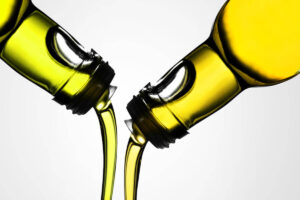Yes, it’s true that Italy is the second olive oil producing country in the world, it’s also true that olive oil has been at the base of our food pyramid for centuries and it is also true that, as Italians, we are very jealous of this excellent local product of ours. However we must make a point and admit that there is still little ignorance on the topic of “extra virgin olive oil“.
Common mistakes are made every day after tasting a good extra virgin olive oil… for example?
When tasting, many consumers attribute the spicy and bitter sensation of an olive oil to poor quality, when in fact it is synonymous with freshness of the product and richness of the active ingredients; or, many judge extra virgin olive oil based on its colour, without actually knowing that the color of olive oil has no value in terms of quality and we must not be misled by this detail.
The culmination of the inexperience of most olive oil consumers comes when they are asked a simple question: what is the difference between extra virgin olive oil and olive oil? Because yes, they are two opposite products with substantial and decisive differences.
Extra virgin olive oil has very precise and well-defined chemical and organoleptic characteristics: colour, smell, consistency and degree of acidity, which must not exceed 0.8 grams per 100 grams of product. Furthermore, it must be pointed out that extra virgin olive oil is obtained from the mechanical pressing of the olives alone. It’s like taking some olives, squeezing them and getting just an olive juice; so we could easily explain what extra virgin olive oil is and how it is produced by this saying.
In fact, when the olives reach perfect ripeness, they are harvested and pressed by specific high-tech machinery, which allows the maintenance and conservation of all the scents, aromas and organoleptic properties. In addition to the classic steps such as washing, milling, centrifugation and final filtration, it is worth underlining that European regulation number no. 2568/91 has established very precise quality standards so that an olive oil can actually be sold as “extra virgin oil” and here’s the reference is made to the temperature maintained during production.
“Extra virgin olive oil – cold extracted” this is the wording that is often found on the labels of bottles of high quality extra virgin olive oil. But what does that “cold extraction” mean?
It simply means that, if you want to obtain and consequently sell extra virgin olive oil, then this product must be extracted using cold mechanical tools, with temperatures that do not exceed 27 degrees C° (80/85 F°) – the optimal temperature for preserving the taste and properties. organoleptic characteristics of the olive oil itself.

Olive oil, on the other hand, is simply a mixture composed of a refined oil, i.e. obtained through the heavy use of chemical substances, and a virgin oil, which is an olive oil produced in the same way as extra virgin but which does not fully satisfy those analytical and organoleptic parameters such that it can be included among extra virgin oils. In this case, an important parameter to control is the acidity rate which goes from a maximum of 0.8 grams to a maximum of 1 gram per 100 grams of product.
After this short but intense journey to discover high quality extra virgin olive oil and its difference from classic olive oil, below we are sharing a brief classification of the different oils in circulation, so as to leave no room for mistakes anymore.
• Extra virgin olive oil: extra virgin olive oil has the most valuable organoleptic characteristics with the presence of oleic acid must remain below 0.8 grams per 100 grams.
• Virgin olive oil: it is less pure than the previous one. Its acidity index must not be above 2 grams per 100 grams.
• Lampante virgin olive oil: like virgin and extra virgin olive oil, it is obtained through mechanical pressing. But unlike the latter it has organoleptic defects and high acidity, it is not edible. Its acidity index exceeds 2 grams per 100 grams.
• Rectified olive oil: it is produced by refining lampante oil. It does not have the typical flavor and aroma of olive oil.
• Olive oil: it is a mixture of refined oils and virgin olive oils with an acidity level of less than 1%.
• Raw pomace oil: it is made with the residues of pressing and is extracted using chemical solvents. It is not edible.
• Olive pomace oil: it is not edible and it is bleached, deodorized, stripped of acidity and refined. Only by adding a certain quantity of virgin oil does it become a product to be consumed at the table.
And you? Did you know that there were all these different classifications of oil?